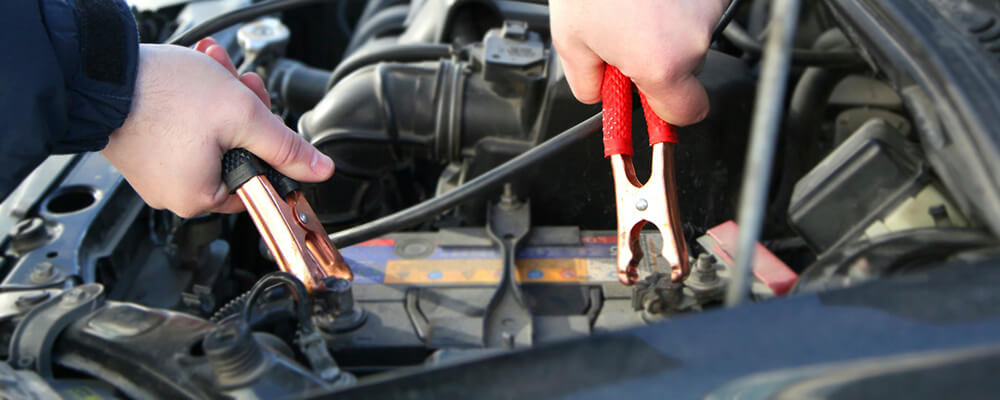
The best deep cycle battery charger saves the battery in cold weather, in the case of electrical problems, and other factors that might make it drained. This product is designed to feed the car or marine batteries relatively slowly up to their full bars.
The following descriptions are about affordable, top-quality devices that deliver high current on demand and always output the right current at the necessary voltage during the entire charging cycle.
The list of items below demonstrates easy-to-use devices that need just a solid connection to do their job. All the units mentioned in the post could stay plugged in the car battery all the time when the latter is out of the vehicle. This feature is critical for those often leaving their cars for a long period in garages.
Read the reviews of the most popular model and choose the appropriate model for your budget.
Deep Cycle Battery Charger Reviews
Battery Tender Plus — Best Deep Cycle Battery Charger

The Battery Tender Plus is a 1.25-amp single-bank charger and maintainer to feed one battery at a time. It works flawlessly for all the 24-volt appliances, including RV, motorcycle, ATV, and marine batteries. The device tops off batteries with a low charge as long as they can hold the power. When it shows 80%, it takes the unit nearly 4 hours to make it to 100%.
The unit still works when it gets wet. It doesn’t overload the battery and stops the process when the cables are hooked up incorrectly. The smart appliance finds the relevant load level for a battery, considering its power level and type. It automatically toggles to a float mode when the battery is fully charged. Generally, the entire process consists of four levels: initialization, bulk charge, absorption, and floating.
The deep cycle battery charger features a metal housing with tight connections, durable wires, and energy-efficient copper clamps. The red indicator on the top starts blinking to notify about the completely drained battery or improper connections. The green light blinks when a battery is 80% charged. The unit needs a shelf since its cables come out from the back panel, making it challenging to store the device on the wall.
Pros
- There are terminal connectors in the package to connect them to a battery without using the clamps. Besides, this hardware is suitable to feed mobile devices.
- The unit is shock- and vibration-proof.
- It fits both flooded and sealed lead-acid batteries of any size.
Cons
- The unit is not capable of feeding completely dead batteries.
- The clamps are too small to fit large terminal posts.
- It lacks the indicator to show the current charge level.
NOCO GENIUS1 — Best Deep Cycle Marine Battery Charger
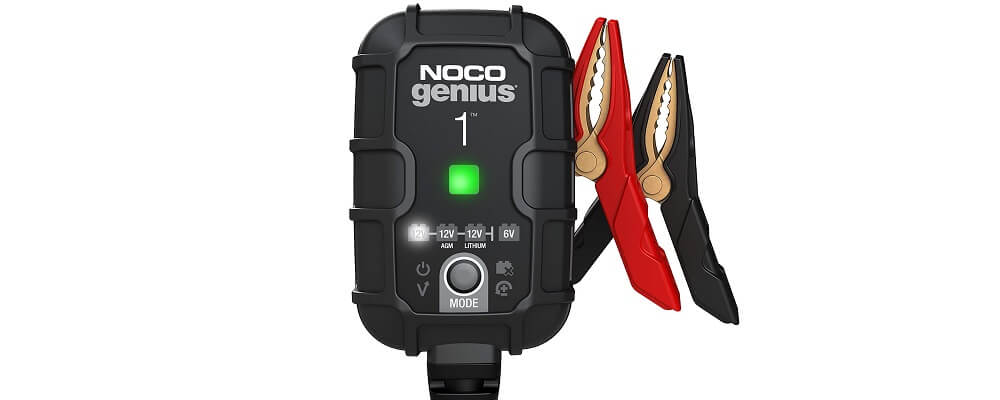
This 1-amp charging deep cycle battery with 12V SAE barrel connector works with batteries up to 30Ah. It operates in several modes. For example, the Force Mode comes in handy when it’s necessary to recharge a dead battery that even the connected device cannot identify it. So, it’s possible just to activate the force mode and leave the charger hooked up until it starts reviving the dead battery.
The Force Mode stays active for 5 minutes, and then the device continues to recharge a battery in a normal mode. After the battery is 100% charged, the device automatically toggles to a maintaining mode. If the power goes out for some reason, the unit “remembers” the mode that allows avoiding pushing the buttons in search of a required mode.
The device plugs into the power outlet via the 85-inch cord. The unit comes with a 21-inch cable that has removable plastic clamps with metal jaws. A single button on its cabinet helps choose one of several charging modes. They are not labeled but look like 4 LEDs. It’s not very convenient since it’s necessary to press and hold the button for nearly 7 seconds to see 4 LEDs activated and to choose the required mode.
Pros
- The unit supports lithium phosphate batteries.
- The manufacturer claims IP65 level, meaning the device’s ability to withstand powerful jets of water. No doubts about it. It features rubberized male and female connections to protect the contacts from dust and water.
- The unit can automatically detect temperature.
Cons
- It’s necessary to buy accessories separately, including terminal connectors.
- It takes the unit more than three days to handle large batteries that are almost empty.
- The connectors have a uniquely different shape that makes it impossible to use after-market accessories.
NOCO GENIUS10

The deep cell battery charger is compatible with a 6V and 232Ah battery. It works with marine batteries, SUVs, and tracks even with a couple of batteries connected in parallel. The device detects the current voltage and chooses the relevant amperage up to 10A. This feature protects the battery from overloads and makes the charging process more efficient.
The unit is remarkable for its temperature compensation, meaning the ability to automatically adapt the profile to a current temperature in the garage or outdoors. The device is recommended to use in temperatures from -680F to +1040F. Like many other compact models, it is fitted with natural convection, meaning no fans for cooling.
Many other units in this price segment don’t detect dead batteries, while this one has 1-volt start voltage sensing and Force Mode to feed the batteries with less than 1V of power. It also has a Repair Mode to recover old batteries. Working in Supply Mode, the device provides engine management, in particular, programming the ECU. The unit saves the chosen mode in its memory and uses it next time it recharges the battery.
Pros
- The device always charges the batteries to full capacity while many other models reach nearly 90%.
- It is compatible with all the battery types: CA, Wet, AGM, GEL, EFB, Calcium, MF, and Lithium.
Cons
- It would be great to see a current or voltage meter in this model.
- The manual is confusing, with small fonts and unclear instructions.
Schumacher SC1281
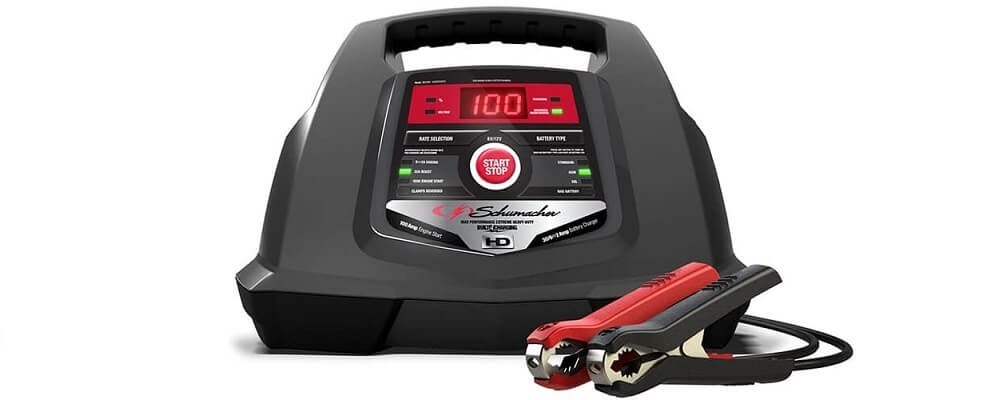
Those having a car, truck, tractor, lawnmower, or boat should consider the 30-amp deep cycle charger from Schumacher. Such a quick boost makes it possible to feed the battery for a couple of hours. Besides, it has a 100-amp engine to jump-start the vehicles’ dead batteries.
The device can boast reverse protection, meaning no sparkles and accidents in the case of the wrong connection. The unit tracks amperage to prevent overloads; that’s why it can be used for maintenance.
A digital display on the plastic cabinet shows the battery’s voltage, the on/off status, and the charging process. If it shows “OFF” once the user activates the unit, it means that something is wrong with the battery. The buttons to start/stop the charge, to choose the rate and the battery type, and other indicators are on the front panel beneath the display.
If the battery doesn’t fit any of the offered types (AGM and Gel), just choose the “Standard” option. The device runs the desulfation mode that makes it compatible with batteries of all types. While choosing the rate, the user selects between 6V/2A charging, 3A boost capability (for large-sized batteries), and 100A engine start.
Pros
- Two taps on the back panel allow coiling up the cord when it’s not used.
- It reads the batteries’ voltage accurately.
Cons
- While feeding the battery, the display goes into sleep mode and doesn’t notify the percentage of charge or the battery’s voltage. The user has to switch it back on manually by pressing any button.
- The screen turns off sometimes. It’s necessary to press the “Start” button to bring it back.
BMK EPA1205

The deep cycle marine battery charger features 4-step process based on a smart microprocessor inside the device. This model is compatible with all types of batteries within the range of 15–100Ah. The unit has full protection against short circuits, sparks, and backward connections. The device feeds batteries relatively fast, making them full in 12-13 hours on average. The precise number of hours depends on the batteries’ capacity. For example, the largest 100-amp batteries need 22 hours of charging.
It withstands temperatures from -50F and 1200F, tolerating their sudden fluctuations. However, it cannot compensate for lower temperatures that might have prolonged the batteries’ life in severe weather conditions. The unit boasts an IP65 rate of waterproofing, having the sealed casing and the clamps that are entirely isolated to prevent the possible ingress of moisture. The appliance can recognize the battery’s condition to recover dead ones and to remove sulfates by dropping them back to the acid and dissipating them as a result.
The cabinet is made of durable ABS plastic. Several indicators show the device’s status and other information. Many other models in this price range have only or just a couple of LEDs. The EPA1205 discloses 25%, 50%, 75%, and 100%, and 4 stages of the charging process. The LEDs flash when the particular level/stage is on track, and they are steady when it is completed.
Pros
- The unit corrects the charge based on the battery’s inner processes.
- The device indicates the charging stages accurately.
Cons
- The appliance gets hot while feeding the deep cycle battery.
- The AC cord is 3 feet only while many other models feature 6-feet and longer cords.
NOCO Genius G1100
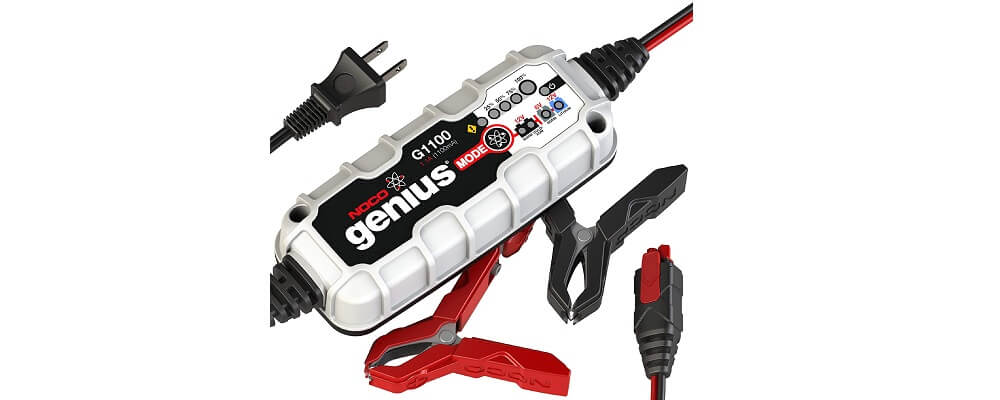
This 1.1-amp model is suitable for both ground and marine transport’s deep cycle battery charging if the vehicles have 6 – 12-volt small-capacity batteries of up to 40Ah. The unit eliminates sulfates and works flawlessly in cold weather (-500F), compensating for the temperatures, stabilizing the batteries’ chemistry.
The appliance can reveal damage or completely dead batteries, giving the latter a high-volt jump to start the vehicle. At the same time, the unit maintains batteries, keeping them full without overcharge for long periods. The energy-efficient unit reduces electricity consumption when it doesn’t work at its peak power.
The status lights show 0-25%, 25-50%, 50-75%, and 75-100%. The device has a rubberized underside, high-quality fuse-protected wires, and tight connections. It comes with the 6-feet power cord, clamps (they open widely to fit any bolt’s size), and eyelet terminals to use them instead of regular clamps. The latter are small and need to be drilled out to fit many batteries. The device has two screw holes to mount it somewhere.
Pros
- The pack is full of accessories, including eyelet terminal connectors.
- It automatically loads CANbus systems.
- It handles two batteries at the same time.
Cons
- It’s necessary to buy a standard 2-pin SAE adapter separately.
- The unit is vulnerable to water.
Schumacher SC1280

The 12V deep cycle battery charger is compatible with up to 15-amp car, SUV, RV, truck, and marine batteries to revive them fast and then to go into maintaining them. The automatic microprocessor turns the unit off when something goes wrong. The unit can power the battery for 1–10 hours, depending on the battery’s capacity.
The Schumacher deep cycle battery charger is portable and has a convenient handle to take it anywhere. The unit’s interface is easy to understand without instructions. The multiple LEDs feature real-time updates of the charging status, and the screen displays the current voltage. The buttons on the right help choose AGM or GEL battery type or select the “Standard” button for other batteries’ types. The buttons on the left allow choosing between 3A and 15A rates.
The display goes into stand-by mode sometimes, and once it turns on again, it might get stuck at 80%. Then, it continues to charge rather slowly.
Pros
- The power cord is 7.75 feet long.
- The Schu ECO Energy label shows the unit’s highest energy-efficiency.
- It always measures voltage correctly.
Cons
- This model is not recommended to connect to multiple batteries at the same time.
- The built-in cooling fan is noisy, working all the time during the charging process.
NOCO GENIUS2
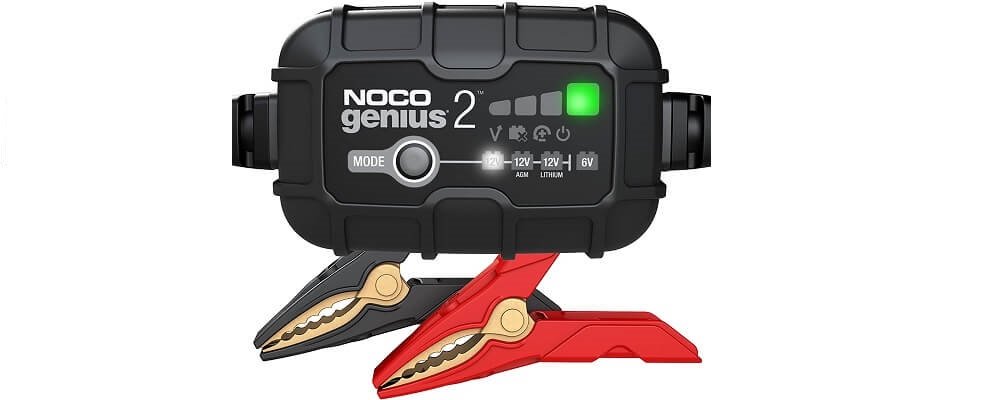
This device is another model from NOCO deep cycle battery chargers with 2A of current and 30V of output power. It features Force Mode to cope with drained batteries below 1V. There is no need to manually activate desulfation since it happens independently at the start of the cycle. Thermal compensation calibrates the volume to ensure a highly-efficient charge. It’s possible to use the device outdoors, but it is not water-resistant.
The cabinet is made of durable plastic with weatherproof buttons. The deep cycle battery trickle charger has a decent set of accessories. It comes with a 72-inch power cord and 56-inch cables, 2 clamps, eyelet terminals, mounting bracket and strap, and 2 self-tapping screws. The LEDs are dim, which makes them challenging to see in bright sunlight. Four LED indicators show the progress. Four more LEDs beneath them display the type of the connected battery.
Pros
- The rubberized base prevents the unit from slipping and scratches.
- The device is powerful enough to recharge almost dead batteries for a single day or overnight.
Cons
- The device cannot repair and supply 12V batteries. That’s why the additional repair is necessary for heavily sulfated batteries.
- It lacks the 6V AGM mode.
Buyer’s Guide
How to Charge a Deep Cycle Battery Properly
Before charging deep cycle batteries, it’s possible to remove them from the car/truck or watercraft or leave them sitting inside the vehicle. It’s crucial to use an appropriate type of charger to ensure 100% of charge and to avoid damage.
The process usually involves a 4- or 3-stage battery charger deep cycle:
- The device outputs its peak power for the initial boost.
- The unit gradually decreases voltage and activates the slow-load mode to feed the battery to 100%.
- When the battery is full, the device starts maintaining it to keep it full without overcharging.
The fourth stage is relevant to wet or flooded batteries. It is called equalization and serves to adjust the maintenance based on the battery’s feedback. It removes sulfates and helps avoid electrolyte stratification.
In this way, the vehicle and marine deep cycle battery charger balances its rate, and automatically stops when the battery is full. Let’s see how to charge a deep cycle battery with a battery charger:
- Take and plug the AC power cord into the wall socket.
- Connect the positive red cable with a red clamp to the positive terminal and the negative black cable with a black clamp to the negative terminal. Note that it’s possible to use eyelet terminals instead of alligator clips (clamps).
- Turn the charger on to initiate the process.
- Disconnect the clamps and cables from the battery and the device. Alternatively, it’s possible to leave them connected to keep the battery full when the vehicle is not in use.
Some other steps are possible, but they depend on the model. For example, the Schumacher devices require manual choice of the battery’s type and rate. Note that it’s not recommended to use multiple sources simultaneously, combining, for example, a battery charger for deep cycle batteries and a solar feeder.
Deep Cycle Battery Charger vs Regular
Regular chargers are designed for a fast charging process, being suitable for average lead-acid batteries that output a lot of power for a short period. They often indicate 100% of power but, in practice, let the batteries reach only 80% of their capacity.
Deep cycle batteries are specially made with thick batteries to be capable of multiple charge and discharge cycles. Deep cycle batteries ensure stable power for a relatively long period; that’s why they need slow-charge technology to reach the highest possible capacity. So, a battery charger for a deep cycle battery tops off both marine and motor vehicles slowly, giving the batteries 100% of the power. It works safely without producing heat, while regular ones need a cooling-off period.
The regular model turns off automatically when the battery is full that reduces power consumption and prevents overloads. A battery charger for deep cycle marine battery continues to work that makes the user manually shut it off. However, it provides the battery’s maintenance and keeps it always fully charged and in good working order without overcharging the battery.
What Kind of Charger for Deep Cycle Battery is Needed
Both marine and motor vehicle batteries need a charger that has a relevant amperage to fit a specific battery’s size. For example, a 10-amp deep-cycle device will feed the 50Ah battery for approximately 6 hours. At the same time, it will take more than 11 hours to full a 100Ah battery. So, it would be wiser to opt for a model that can feed the battery for the shortest possible period. However, if time is not essential, it’s possible to acquire a cheaper compact unit.
Many manufacturers disclose the charge time on their websites or in manuals. However, it’s possible to calculate it independently. Just divide the battery’s mAh rating by the amps and add about 10% for the extra time to charge the battery. It’s also important to consider the battery’s input voltage, which is different in a marine or a motor vehicle’s battery. For example, its range in a marine battery is 120 or 230 VAC.
There are several types of devices on the market:
- Deep cycle battery chargers also work as maintainers. They are indispensable for those who have to keep their vehicles’ batteries full when they don’t use them for a long period.
- Regular chargers are suitable for drivers who use their vehicles constantly and want to top off the batteries fast.
- Jump starters fit the drivers who cannot rely on their batteries on the road. These devices boost the dead vehicle’s batteries to let the drivers be on their way.
- Multi-voltage units come in handy to those traveling by car to another country. They might toggle between voltages automatically or manually.
- Waterproof models are critical to use them in harsh weather conditions or to top off marine batteries.
- A wide temperature range should be considered if the user lives in cold or hot climates.

My name is Brandon, and I’ve been interested in cars since I was a kid. I got a bachelor’s degree in Automotive Technology and worked in a private car workshop. I have two cars that have been completely upgraded with my own hands. So I successfully put all my knowledge into practice.
Last update on 2025-07-05 / Affiliate links / Images from Amazon Product Advertising API





